Abstract
This paper evaluates the biodiesel produced by a biodiesel plant located in the Mexican Centre for Cleaner Production (CMP + L by its acronym in Spanish) of the National Polytechnic Institute of Mexico. Pollutant emissions from two types of engines were studied: a low power monocylinder engine and a 30-kW electric generator diesel engine. The tests were performed with the following blends: B5, B10, B15, B20, B30, B40, and B50. Parameters such as carbon monoxide, nitrogen oxide, hydrocarbons, and combustion efficiency were analyzed, as well as sulfur dioxide, oxygen, and combustion temperatures. It was demonstrated that NOx increases as the percentage of biodiesel increases, while CO decreases slightly using the monocylinder engine. In the case of the electric generator diesel engine, the B5 mixture had the highest trend for NOx and the lowest trend for CO. Likewise, combustion efficiency was found to be severely affected by the biodiesel blends, i.e., from B5 to B20. An analytical study and experimental thermography tests of the combustion process with biodiesel blends were carried out, and the technical problems of operation when incorporating biodiesel blends are presented.
1. Introduction
The industrial revolution established new forms of production, such as serial and mass production. Since then, the use of fossil fuels has been an indispensable energy resource. However, some of the consequences of its use are damage to the environment and the health of living beings.
An example of this is Mexico City, which is one of the most polluted places in the world, where the implementation of the Kyoto protocol was carried out in 1997. This protocol establishes the percentages of reduction in greenhouse gas emissions, stating that a reduction of at least 5.25% in CO2 emissions is required, a request that the federal government undertakes to comply.
The government has previously tried to implement programs aimed at reducing pollution levels. The best known was the program “Hoy no circula”, introduced in 1989, in which cars that did not reach the emission criteria could not be used on a given day of the week, depending on the last number of the vehicle license plate. Analyzing the impact of this program with a regression discontinuity design, Germá Bel et al. mentioned that this policy was not effective [1]. There was cause for alert when Mexico, in 2011, was in 13th place among the top 15 countries generating the most greenhouse gases (GHGs), being responsible for 2% of total GHGs released into the atmosphere, one of the main factors responsible for global climate change [2].
According to the Global Database on Air Pollution in Urban Environments, reported by the World Health Organization in 2016, Mexico City ranked as the seventh most contaminated city by fine suspended particles [3]. In the same year, the Mexico City government began a reforestation program, where the sanitation and reforestation of avenues and ridges were carried out with suitable species for climatic and urban conditions. According to the World Health Organization (WHO) in 2008, around 1.3 million people die annually because of air pollution; 3.7 million died in 2012. Additionally, more than two million premature deaths were related to air pollution [4].
It has been estimated that 24% of the global disease burden and 23% of all deaths can be attributed to environmental factors [5]. Experts who have worked for the Mexico City government have said that the pollution rate is derived from the increase in the number of vehicles, the majority of which circulate daily. In comparison to the engine using gasoline, diesel engines are widely used in medium and heavy applications due to their lower fuel consumption, lower emissions of carbon monoxide (CO), and unburned hydrocarbons (HC) [6]. For these reasons, particles causing the greenhouse effect should be minimized; hence, the use of biofuels, especially biodiesel, may represent a different option.
The raw material used in the biodiesel production process is varied (e.g., different types of vegetable oils and animal fats, recycled oils), making the corresponding chemical reaction result in a multiplicity of esters of different fatty acids in variable proportions, all of them called biodiesel [7]. Transesterification is a chemical reaction that has shown the best results in obtaining biodiesel. A triglyceride reaction (composed of a molecule of glycerol esterified by three molecules of fatty acids) is contained in vegetable oil, animal fat, and light alcohol (methanol or ethanol). Glycerin products and esters derived from the three starting fatty acids are obtained as biodiesel. In general, methanol is used as an alcohol replacement, in which case biodiesel will be composed of methyl esters [7]. Transesterification depends mainly on the amount of alcohol, catalyst, pressure, time, FFA (free fatty acids), and the amount of water. Oils with a large amount of free fatty acid are difficult to process because they will form a soap solution in the presence of the catalyst [8]. In terms of fuels for diesel engines, there are several factors affecting suitability. A critical characteristic is the number of cetanes (CN) that is used as a measure of combustion quality. The higher the cetane number, the faster the fuel evaporates, inducing an increase in the pressure inside the cylinder. This faster transition, from liquid to gas, can result in greater output power, allowing higher engine speeds [9].
The compounds that can be found during the exhaust emissions in an engine and their respective effects are listed as follows:
- ○
- Sulfur dioxide (SO2) is a colorless gas that is mainly produced during the burning of fossil fuels containing sulfur. According to the 2014 emissions inventory [10], a high concentration of this contaminant can damage the lungs and generate infections, especially if it is in amounts greater than 1.5 ppm, and it may present with bronchial constriction and respiratory infections [11].
- ○
- In addition, nitrogen oxides (NOx) are generated in combustion processes by the reaction between atmospheric nitrogen and oxygen. The term nitrogen oxides generally refers to the sum of the concentrations of nitric oxide (NO) and either nitrogen dioxide or nitrous oxide (NO2) [12].
- ○
- Carbon monoxide (CO) is a tasteless, colorless, and odorless gas. In the atmosphere, it plays a minor role as a greenhouse gas because of its ability to absorb small amounts of infrared energy radiation [12].
- ○
- Finally, hydrocarbons (HC) means the collective concept of almost all chemical compounds of carbon and hydrogen. HC emissions are attributed to incomplete combustion of the air and fuel mixture due to a lack of oxygen. Partially oxidized hydrocarbons (e.g., aldehydes, ketones) smell unpleasant and form secondary products that, with the lasting action of specific concentrations, are also considered carcinogens [13].
Biodiesel has become an attractive fuel due to its efficiency and low cost compared to gasoline [14]. In addition to reducing unburned hydrocarbons (HC) and CO particles, it can also increase the amount of NOx [15]. Biodiesel has similar properties to those of diesel; for example, it is similar in cetane number. It has the property of being biodegradable, improving lubrication, and it is not particularly toxic [14]. Many researchers agree that the biodiesel used in internal combustion engines generally causes a decrease in soot, HC, CO, and PM, but it generates an increase in NOx emissions [15,16,17]. Recent research has shown the problems caused by the use of biodiesel in internal combustion engines; researchers have concluded that the use of pre-injection systems reduces soot, as well as HC and CO emissions. However, NOx emissions are higher in comparison to the result obtained for mineral diesel [18]. That is why the injection system is important; it is responsible for polluting emissions such as NOx [15]. Another common problem is the characteristics of the combustion chamber, as shown by other research on combustion performance [19].
The use of biofuels in engines, due to their properties, can cause some disadvantages. A specific example is incomplete combustion [20]. The effect of this incomplete combustion is reflected in the increase of some polluting gases in tests made with biofuels in diesel engine generators, showing a reduction in HC and CO but an increase in NOx [21] and a decrease in the emission of suspended particles (PMs) and CO2 [22]. There are many studies related to electric generators; alternative fuels have been analyzed to find the ones that offer the most significant benefits, with biodiesel considered the best alternative to meet the world’s energy demands [23]. Thermal efficiency, engine performance, fuel consumption, and gas emission are the most important parameters to evaluate them. Governments, automotive manufacturers, and biodiesel producers have carried out research and development programs for biodiesel–diesel validation tests [24]. There are physical phenomena in the use of biofuels; for example, when biodiesel and ethanol contain water, they show a reduction in the initial sulfur portion as well as the content of polycyclic aromatic hydrocarbons. However, CO emissions increase as there is incomplete combustion of fuels due to low combustion temperatures [25]. In other investigations related to electric generators (with diesel engines), there have been increases in HC and CO2, but NOx and CO are reduced [26]; even the reduction of sulfur dioxide (SO2) has been reported [23]. Some of the reasons for these behaviors lie in the biofuel’s chemical composition: the increase in oxygen in the fuel produces high temperatures that generate these polluting gases [27]. The importance of pressure and temperature conditions to which the combustion chamber is subjected and the adequate formation of the air/fuel mixture are factors that influence the generation of polluting emissions [28]. The importance of these gases lies in the fact that they generate health problems in human beings while damaging the environment, either by affecting soils or causing acid rain to fall in contaminated areas [29].
This research validates the use of biodiesel (biofuel based on residual vegetable oil) by analyzing polluting emissions and combustion efficiency in a monocylinder engine and an electric generator, both four-stroke. The biodiesel was developed at the National Laboratory for Development and Quality Assurance in Biofuels (LaNDACBio by its acronym in Spanish) of the Mexican Center for Cleaner Production that belongs to the National Polytechnic Institute of Mexico. This study proposes a new alternative to biodiesel applied to low-power engines and electric-generator diesel engines because the operating conditions required for this type of application are not that demanding compared to transport applications. It is also relevant to reducing the environmental impact in highly polluted cities; for example, in Mexico City, there are many stationary diesel combustion engines where it can be applied.
This paper is organized as follows: In Section 2, the materials, equipment, and methodology for the experimental tests are defined and the characteristics of the single-cylindrical motor and the electric generator are shown; the results obtained and other relevant works are discussed in Section 3; additionally, an analysis of the combustion process and experimental thermography tests is shown in this section; finally, Section 4 shows the conclusion and possible future work.
2. Materials and Methods
The biodiesel used in this study was produced at the biodiesel plant located in the Mexican Center for Cleaner Production (CMP + L by its acronym in Spanish) of the National Polytechnic Institute of Mexico; all the chemical reactions derived from residual vegetable oil were carried out with alcohol (in this case, methanol), producing a total of approximately 800 L of biodiesel, with around 200 L of glycerin as a byproduct. The characteristics of the biodiesel are shown in the Results section. Experimental tests were performed using two types of combustion engines: the first engine is a four-stroke low-power monocylindrical engine and the second engine is an electric four-stroke generator, both described below.
2.1. Equipment and Materials for Experimental Tests on a Low-Power Monocylinder Four-Stroke Engine
This test describes the experimental methodology of polluting emissions and combustion efficiency. For this test, three types of equipment were used:
- Four-stroke low-power monocylindrical engine
- Electronic circuit
- Exhaust gas analyzer
Table 1 shows the parameters and characteristics of the engine used for this experimental test.

Table 1.
Technical characteristics of the engine.
Figure 1 shows the engine used; this is composed, in general terms, of a fuel tank, an air filter, an oil filter, a fuel stopcock, an accelerator, an intake manifold, and a mechanical and electrical ignition.
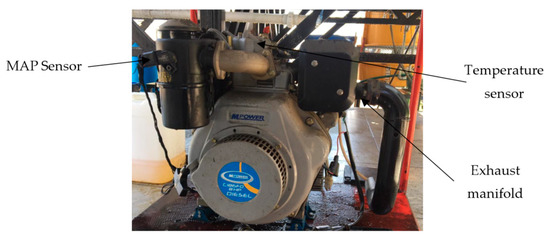
Figure 1.
Mpower cylindrical mono diesel engine.
The circuit was designed and assembled with a set of electronic and programming elements for measuring parameters such as revolutions per minute (RPM), absolute pressure, and temperature. Automotive sensors were used, such as MAP sensor, rpm sensor, and temperature sensor; the parameters were displayed on a 16 × 2 inch LCD screen. For the measurement of these parameters, a free hardware programming board (Arduino UNO) was used with the code required for the conversion of analog-to-digital type signals. In addition, the screen mentioned is used to display the measured parameters. Figure 2 shows the speed sensor per minute that was installed on the rear of the engine, together with a 45-tooth gear mounted to the motor output shaft. This sensor contained a soft iron core (polar spike) surrounded by a winding. The polar spike communicates with a permanent magnet. There is a magnetic field that extends over the polar spike and penetrates the pulse wheel.

Figure 2.
Revolutions per minute (RPM) sensor and gear coupled to the motor output shaft.
Figure 3 shows the placement of the intake manifold absolute pressure (MAP) sensor in the engine air filter.
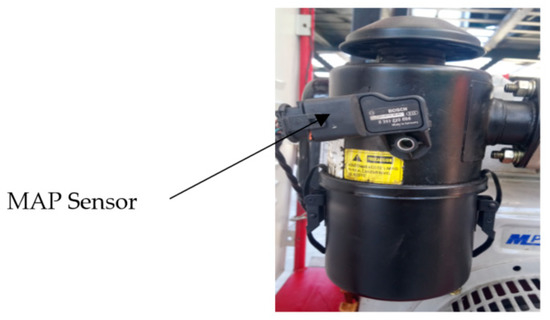
Figure 3.
Air pressure sensor placed in the engine air filter.
For the gas analysis, the BACHARACH® ECA 450 environmental combustion register was used. This is an environmental emissions analyzer that provides information on different combustion parameters like O2 = % Oxygen, CO = Carbon Monoxide, EFF = % Combustion Efficiency, CO2 = % of Carbon Dioxide, TSTACK = Chimney Temperature, TAIR = Ambient Temperature, EA = % Excess Air, NO = Nitric Oxide, NO2 = Nitrogen Oxide, and HC = % Fuel (methane base).
2.2. Experimental Methodology Low-Power Monocylinder
Experimental tests were performed with different proportions of blends: 100 wt % fossil diesel (B0), B10, B20, B30, B40, and B50 (where 10, 20, 30, 40, and 50 represents the wt % of biodiesel); 1-L volume was used to do the tests. To obtain combustion values, the following steps were performed:
- The mixtures B0, B10, B20, B30, B40, and B50 were produced to obtain greater accuracy.
- The mixture was poured into the diesel engine fuel tank.
- The engine was preheated with the corresponding blend, lasting 5 min, then, the regulation of fuel injection pressure and operating temperature were measured.
- The engine revolutions were adjusted at 2000 rpm (at this point, the maximum power and torque were obtained according to the engine’s peak performance).
- The gas probe was placed for 5 min in the exhaust pipe according to the manufacturer’s specifications, after which the ECA 450 equipment automatically gave the data.
- The experimental tests were performed with 5 min lapses in each measurement; then, measurements were made for each percentage of blending.
- At the end of each test, the fuel tank was purged to leave it clean for subsequent tests, and the amount of remaining blend was stored in containers.
2.3. Equipment and Materials for Experimental Tests in Electric Generator
For the experimental tests on the electric generator, three types of equipment were used: (1) 30 kW nominal multiphase generator, (2) 434 B multiphase Fluke electrical network analyzer, and (3) BACHARACH® PCA 400 exhaust gas analyzer. The corresponding characteristics are described in Table 2.

Table 2.
Technical characteristics of the electric generator.
- (A)
- Three-phase generator, with 30 kW Nominal/Closed/Manual Start. The technical characteristics are shown in Table 3 below.
 Table 3. Properties of diesel and biofuel for analytical combustion analysis [30].
Table 3. Properties of diesel and biofuel for analytical combustion analysis [30]. - (B)
- Technical data of the exhaust gas analyzer: the BACHARACH® PCA 400 is an industrial-grade handheld emission and combustion analyzer. This analyzer measures combustion efficiency (%Eff), carbon monoxide (CO), and nitrogen oxide (NO), among others.
- (C)
- Fluke® 434 B multiphases (electrical network analyzer) is the perfect tool for advanced energy registration and monetization; identifying the areas of most significant energy waste of facilities, this analyzer measures voltage, current, frequency, harmonics, voltage fluctuations, and electrical power, among others.
2.4. Methodology for Experimental Tests in Electric Generator
This test describes the experimental methodology of polluting emissions and combustion efficiency in an electric generator. These experimental tests were carried out under the following procedure: the Fluke electrical network analyzer was installed near the output connection of the electric generator (the connection was three-phase), with the aim of measuring the three phases of the electric generator. Subsequently, the BACHARACH® PCA 400 exhaust gas analyzer was installed according to the manufacturer’s specifications (see Figure 4). Drastic industrial safety measures were taken due to the industrial-grade equipment that was handled in this study.
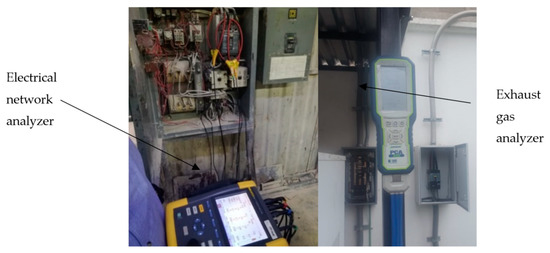
Figure 4.
Connection of the network and exhaust gas analyzer.
The blends B0, B5, B10, B15, B20, and B25, which were taken for experimental tests, are observed in Figure 5. An important fact to mention is that no blends were made at more than 25% because, in a previous test (low-power single-cylinder engine) on the B20 mixture, the polluting emissions values were considerably increased. In this case, it has limited the blend to a maximum B25 so as not to affect the equipment.
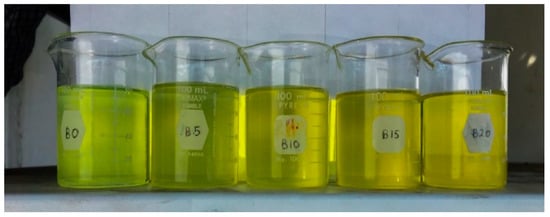
Figure 5.
Biodiesel blends.
Figure 6 shows the containers where each one contains 10 L per blend for experimental tests. With this amount of fuel, the electric generator is kept on for an average time of 30 min. In addition, the electrical power of 6772.8 kW was kept constant; with this load, all emission tests were performed for blends B0, B5, B10, B15, B20, and B25.
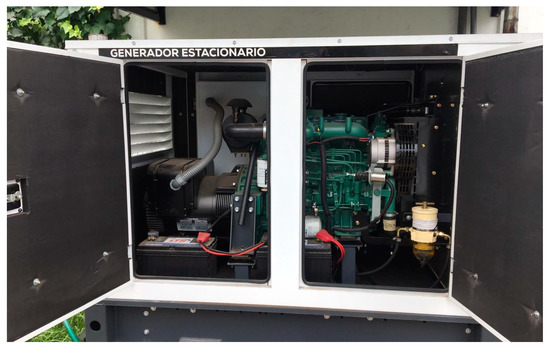
Figure 6.
Experimental emissions tests in an electric generator.
As a complementary analysis, an analytical study of combustion emission volumes and experimental thermography tests of the combustion process were carried out. The methodology used is described below.
2.5. Methodology for Combustion Product Volume Analysis
This work carried out an analytical study of the combustion products in fuel blends; the methodology used in this calculation was by Jarquin et al. [31]. Table 3 shows the properties of biodiesel and diesel that were used for this analysis.
Table 3 shows the content of carbon (C), hydrogen (H), oxygen (O), and sulfur (S) in %. For analytical purposes, the % of sulfur will be considered 0% for biodiesel and diesel due to its low content. Table 4 shows the summary of mixtures between both fuels. This allows us to observe the composition of the elements according to their fuel content.

Table 4.
Compositions of the mixtures according to their percentage of biodiesel.
The following analytical assessments determine the combustion products for 1 kg of fuel, expressed in volumetric units , considering complete combustion under standard conditions of a pressure of 760 mm Hg and temperature of 0 °C. To find the theoretical amount of air required to burn 1 kg of liquid fuel, the following Equation (1) is used [31]:
The variables of C, S, H, and O refer to the content of the elements of carbon, sulfur, hydrogen, and oxygen in Table 4. To assess the theoretical amount of oxygen needed to burn 1 kg of fuel, being , the oxygen density [10] is calculated using Equation (2).
The volume of carbon combustion products is calculated using Equation (3) [31].
The volume of sulfur combustion products is calculated using Equation (4) [31].
The theoretical volume of nitrogen in combustion products is calculated using Equation (5) [31].
The theoretical volume of the vapors in the combustion products is calculated using Equation (6) [31].
The volume of the triatomic gases is calculated using Equation (7) [31].
2.6. Methodology for Experimental Thermography Tests
Experimental thermography tests were performed using the Mpower® motor. The aim is to validate combustion efficiency with biodiesel blends and to analyze the thermal behavior that is reached.
The thermal imaging camera used was the Fluke ® model Ti450 PRO; its main characteristics are shown in Table 5.

Table 5.
Thermal camera specifications.
The biodiesel used is the same in all tests. Thermal behaviors are detailed as follows:
- Blends preparation. Two types of blends were prepared: B5 and B10.
- Biodiesel load to the engine. One liter of fuel was entered into the engine tank for each blend (B5 and B10).
- Tank securing and engine starting. Once the necessary amount of fuel had been deposited, the tank was secured (hermetic seal) and the engine was started. A time of five minutes (warm-up period) was allocated to reach the operating temperature.
- Taking temperatures. During the period of operation, for five uninterrupted minutes and with an average opening of air intake, temperatures were taken with the Fluke ® thermal imager on all the engine profiles.
- Draining the fuel. After taking temperatures, the engine was switched off. The residual fuel was drained from the engine tank and stored in a beaker to verify the amount consumed. This process was repeated for each blend.
3. Results and Discussion
3.1. Characteristics of Biodiesel
The characteristics of biodiesel (derived from the residual vegetable oil) are shown in Table 6. The physical–chemical characteristics of the biodiesel used in this experimental study comply with international standards.

Table 6.
Characteristics of biodiesel.
3.2. Experimental Test Results with the Monocylindrical Engine
The results obtained with the monocylindrical engine are presented in Figure 7. In comparison to pure diesel, it was observed that the B50 blend displayed a decrease of 11.5% in chimney temperature (temperature measured in the exhaust pipe) with respect to the B0; also, there was a decrease in the percentage of oxygen (O2) in the exhaust gases, showing a decrease of 1.14% for the B50 test with respect to B0 (see Figure 7B).
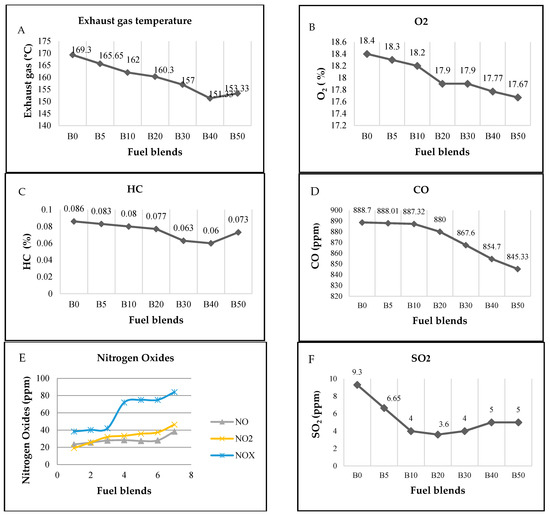
Figure 7.
Experimental results with the monocylindrical engine.
Figure 7C shows the decrease in the percentage of hydrocarbons present in the exhaust gases; this decrease for the B50 blend was 12.5% with respect to pure diesel. The percentage decrease in hydrocarbons shows a positive signal of combustion because this is the main component of air pollution. Figure 7D shows a decrease in CO ppm in the B50 blend by around 3.99% with respect to pure diesel B0; also, there was a decrease in blends B30 and B40 behavior, which is positive because carbon monoxide is one of the main pollutants from low fuel combustion.
In Figure 7E, NO was significantly improved to 62.5% in B50 with respect to B0. Similarly, NO2 showed an increase of this compound in each blend, observing a maximum value of 46.33 ppm, representing an increase of 188.8% with respect to B0. Figure 7E shows an increase in NOx in ppm, and this represents an increase of 114% with respect to B0. Nitrogen oxides cause health diseases such as organ conditions, lung infections, and respiratory failure.
Figure 7F shows the behavior of SO2; the results showed a decrease in SO2 mainly for blends B30, B40, and B50, observing the minimum value in B20 with a value of 3.6 ppm. This represents a positive result for the environment and human health because this compound can cause degeneration in people’s health, from irritation and inflammation of the respiratory system to pulmonary conditions and insufficiencies.
In addition, this compound, when mixed with rain, can be transformed into sulfuric acid, causing “acid rain”, so this compound is of the utmost importance to reduce n vehicle exhaust. In articles related to fuel blends, the use of biodiesel as biofuel, with various advantages, has been seen as positive. Toxicity levels are lower in biodiesel than those presented by diesel, and its performance has a minimal difference. Compared to fossil diesel, biodiesel does not produce sulfides, net carbon dioxide, carbon monoxide, or particles of matter, and there are no smoke or hydrocarbon emissions [32]. An analysis has been made of biodiesel produced with rapeseed oil, which is gaining acceptance in the biofuel market due to the environmental and economic benefits that it provides. Some publications have indicated that rapeseed biodiesel has almost the same performance as fossil diesel and reduces ignition delay, in addition to considerably reducing polluting emissions compared to biodiesel from other raw materials [33]. In a recent study to evaluated exhaust emissions with blends of biodiesel in a single-cylinder diesel engine, it showed that the earlier the injection, the lower the complete combustion and engine performance for all engine loads due to the increased amount of biodiesel cetane [34].
3.3. Experimental Test Results with Electric Generator
The literature shows that real power is the main parameter to be measured in electric generators. This parameter is associated with combustion efficiency—if the generator is closer to its maximum power, combustion is more efficient, to quote. However, other studies have shown that the base product of the biodiesel has an influence on engine performance. An experiment was carried out with parameters similar to those used in this article, with the use of biodiesel derived from jojoba and carbon nanotubes of multiple walls to measure the performance of the engine. Similarly, engine preheating and variation of engine speed led to better burning of the fuel, in addition to similar parameters [35]. In comparison with this work, the main difference is the biodiesel raw material. Figure 8 shows the behavior of the electric generator; clearly, better combustion efficiency is observed when electric power increases.
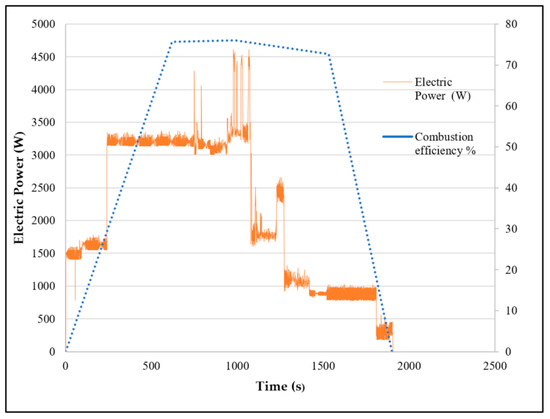
Figure 8.
Electric power vs. combustion efficiency of a electric generator.
CO (carbon monoxide) emissions. Figure 9 shows the graph of (CO) emissions. The B10 blend shows a considerable increase in carbon monoxide compared to the other blends. The generation of exhaust gases due to the geometry of the combustion chamber has been reported in different scientific articles.
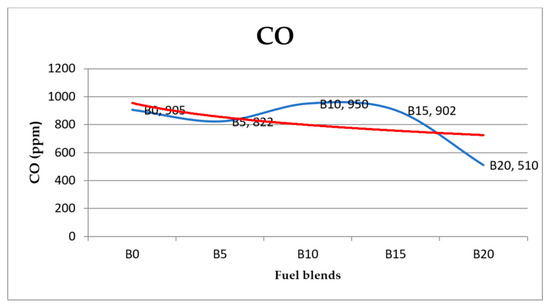
Figure 9.
Carbon monoxide of the electric generator.
Combustion efficiency (%Eff). Combustion efficiency is defined as the ratio of heat released by the fuel to the heat input by the fuel [36]. For combustion efficiency, a considerable difference in pure diesel (B0) and blends B0, B5, B10, B15, and B20 is observed in Figure 10. We can see that B0 tends to be around values of 76% to 77% of efficiency in contrast to the other blends that have efficiencies of 69% to 71%. This could probably be due to the geometry of the combustion chamber, time injection, pressure, temperature, type of fuel, and other factors.
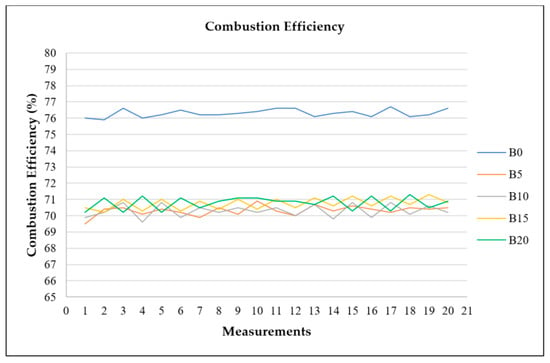
Figure 10.
Combustion efficiency of the electric generator.
NO (nitrogen oxide) emissions. In Figure 11, nitrogen oxide emissions values are observed; for the B5 mixture, they are considerably increased. For mixtures B10 and B15, values with a tendency to decrease NO are observed.
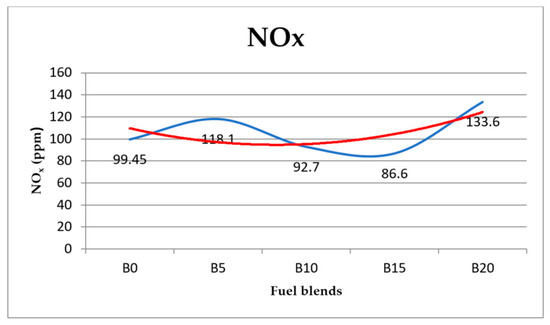
Figure 11.
Nitrogen oxide from the electric generator.
In the previous figure, it shows a similar trend in NO emissions; for example, the B5 blend presents high values for NOx while lower NOx values are presented with the B15 blend.
3.4. Results of Combustion Product Volume Analysis
Table 7 shows the analytical results of the combustion product volume: a decrease is observed in the mass volume of gases (V0), CO2, and O2 as the % of biodiesel, H2O, and N2 increases. It can be stated that the % of biodiesel in fossil diesel significantly affects the combustion process. The results of volumes of combustion products are used to obtain the enthalpy of each gas; this allows us to know the amount of heat generated when burning the fuel. The enthalpy considers a stable flow, temperature, pressure, and volume of the gas, using specific heat at constant pressure. This analysis shows that as the combustion temperature increases, NOx is generated.

Table 7.
Combustion product volume results.
3.5. Results of Experimental Thermography Tests
Experimental thermography tests were performed using the Mpower® motor. The aim is to validate combustion efficiency with biodiesel blends and to analyze the thermal behavior of the combustion chambers.
The results obtained are presented below.
Figure 12 shows the results of the B5 mixture, with maximum combustion temperatures in the chamber of 174.12 and 174.37 °C, respectively. Block temperature reached 73.04 °C, and in accessories, it reached 45 °C.
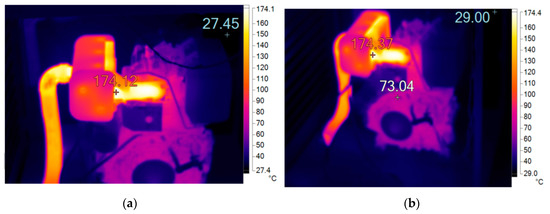
Figure 12.
Maximum temperatures in the combustion chamber with the B5 mixture: (a) temperature in the chamber of 174.12 °C; (b) temperature in the chamber of 174.37 °C.
With the B10 mixture (Figure 13), there was a maximum temperature of 175.6 °C in the combustion chamber. The block reached a maximum temperature of 64 °C. Compared to the previous iteration (B5), the temperature in the combustion chamber increased with the B10 mixture; a summary of these results is shown in Table 8. The importance of this analysis is to corroborate the combustion efficiency through the combustion temperature; the results show an increase in the combustion temperature by increasing the percentage of biodiesel. This has the same trend as the analysis in Table 7.
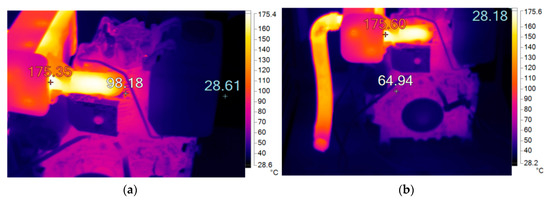
Figure 13.
Maximum temperatures in the combustion chamber with the B10 mixture: (a) temperature in the chamber of 175.4 °C; (b) temperature in the chamber of 174.6 °C.

Table 8.
Result thermography tests.
This work reveals a decrease in carbon monoxide and a considerable increase in nitrogen oxides. On the other hand, another study carried out with canola biodiesel, with proportions of 5%, 10%, 15%, and 20% (% blends) and conventional diesel under different loads in a single-cylinder engine, showed, among several results, that ignition was delayed. However, there was a minimal delay with canola biodiesel; NOx emissions decreased, as well as the generated smoke and CO2 in all charges [37]. Additionally, a recent study by P. Mohamed Shameer and K. Ramesh (2018) analyzed and proposed effective strategies for injection time and pressure in the combustion chamber. The results of the proposed strategies were long ignition delay, finer atomization, lower cylinder temperature, lower gas pressure, and rapid combustion [38]. Based on the results obtained and other scientific studies, it can be concluded that there are many factors that affect the combustion process in a compression engine, and this is reflected in exhaust emissions. These factors are mainly biofuel raw material, injection delay, and the physical characteristics of the combustion chamber, among others.
4. Conclusions
Experimental tests in a single-cylinder engine show the following trend: NOx increases as the percentage of biodiesel increases, whereas CO decreases. It showed a positive behavior of the hydrocarbons present in the exhaust gases, with a decrease of the parts per million of 15.11% of the mixture B50 compared to B0, since the amount of these particles decreased, which could be indicative of better fuel combustion. A continuous decrease of carbon monoxide particles present in the exhaust gases was observed, which represents a decrease of 4.88% with the use of the B50 mixture compared to the B0 mixture.
Considerable increases of 243.8% (NO), 219.32% (NO2), and 46.44% (NOx) in the exhaust gases were observed. In the literature, researchers have reported increases in NO and NO2, related to the physical characteristics of the combustion chamber. A positive behavior of sulfur dioxide was obtained from the first use of biodiesel as fuel, decreasing 56.98% in the first test and maintaining between 4 and 5 parts per million during mixtures B20, B30, B40, and B50; this benefit could reduce the so-called “acid rain” in cities.
In the case of the electric generator diesel engine, the B5 mix presented the highest trend for NOx and the lowest trend for CO. Combustion efficiency is severely affected by biodiesel blends from B5 to B20; this behavior has been reported by other studies, where it is mentioned that combustion efficiency is affected by fuel type, bed temperature, gas velocity, and excess air levels. Combustion efficiency increases with fuel volatile matter content and bed temperature. Combustion efficiency decreases with increasing superficial gas velocity [36].
Biodiesel, as a fuel, may vary depending on proportion of mixture, combustion engine characteristics, and the operating conditions of the engine. The obtained results showed a constant decrease in most of the pollutant gases measured in each test, so it is a viable energy transition alternative for use in combustion engines. However, it is essential to mention that technical and operational problems arose when incorporating biodiesel blends into combustion engines; the main problems were ignition delay and low pressure in the fuel injection system.
Author Contributions
Formal analysis, J.C.P.R. and J.A.L.N.; investigation, J.C.P.R., R.V.M. and F.E.O.H.; methodology, C.R.T.S.M. and R.C.C. All authors have read and agreed to the published version of the manuscript.
Funding
This research was funded by the Secretariat of Research and Postgraduate of the National Polytechnic Institute of Mexico with the following projects: 20200305, 20201433 and 20201964.
Acknowledgments
The authors appreciate the financial support provided by the Secretariat of Research and Postgraduate (SIP) of the National Polytechnic Institute (IPN) Mexico through the SIP 20200305, SIP 20201433 and SIP 20201964 projects. We extend the same thanks to LaNDACBio—CMP+L- IPN for the facilities used in this research work.
Conflicts of Interest
The authors J.C. Paredes-Rojas, C.R. Torres-SanMiguel, R. Vázquez-Medina, J.A. Leal-Naranjo, F.E. Ortiz-Hernández and R. Costa Castellò declare that there are no conflicts of interest regarding the publication of this paper.
References
- Bel, G.; Holst, M. Evaluation of the impact of Bus Rapid Transit on air pollution in Mexico City. Transp. Policy 2018, 63, 209–220. [Google Scholar] [CrossRef]
- World Bank. The World Bank Group. The Climate Change Knowledge Portal (CCKP). 2019. Available online: https://climateknowledgeportal.worldbank.org/country/mexico (accessed on 8 May 2020).
- Instituto Mexicano para la Competitividad. IMCO. Recuperado el 09 de Febrero de 2019. 2016. Available online: http://imco.org.mx/medio_ambiente/base-de-datos-global-urbana-de-la-contaminacion-del-aire-2016-via-oms/ (accessed on 17 July 2020).
- Jiang, X.Q.; Mei, X.D.; Feng, D. Air pollution and chronic airway diseases: What should 589 people know and do? J. Thorac. Dis. 2016, 8, E31–E40. [Google Scholar] [CrossRef] [PubMed]
- Hurtado Díaz, M. Instituto Nacional de Salud Pública. Recuperado el 10 de Febrero del 2019. febrero de 2015. Available online: http://www.inegi.org.mx/eventos/2015/Poblacion/doc/p-MagaliHurtado.pdf (accessed on 25 January 2020).
- Adaileh, W.M.; AlQdah, K.S. Performance of Diesel Engine Fuelled by a Biodiesel Extracted From A Waste Cocking Oil. Energy Procedia 2012, 18, 1317–1334. [Google Scholar] [CrossRef]
- Ganduglia, F. Manual de Biocombustibles. Instituto Interamericano de Cooperación para la Agricultura (IICA), ARPEL ICA-2009. ISBN13: 978-92-9248-121-6. 2009. Available online: http://repiica.iica.int/docs/B2223e/B2223e.pdf (accessed on 30 November 2020).
- Nayak, S.K.; Pattanaik, B.P. Experimental Investigation on Performance and Emission Characteristics of a Diesel Engine Fuelled with Mahua Biodiesel Using Additive. Energy Procedia 2014, 54, 569–579. [Google Scholar] [CrossRef]
- Wood, B.M.; Kirwan, K.; Maggs, S.; Meredith, J.; Coles, S.R. Study of combustion performance of biodiesel for potential application in motorsport. J. Clean. Prod. 2015, 93, 167–173. [Google Scholar] [CrossRef]
- Secretaría del Medio Ambiente de la Ciudad de México (SEDEMA). Calidad del aire en la Ciudad de México, informe 2016. Available online: http://www.aire.cdmx.gob.mx/descargas/publicaciones/flippingbook/informe-2016-calidad-del-aire-en-la-ciudad-de-mexico/mobile/informe_anual_calidad_aire_2016.pdf (accessed on 25 January 2020).
- Jacobson, M.Z.; Hoeve, J.E.T. Effects of Urban Surfaces and White Roofs on Global and Regional Climate. J. Clim. 2012, 25, 1028–1044. [Google Scholar] [CrossRef]
- Secretaría del Medio Ambiente de la Ciudad de México (SEDEMA). Calidad del aire en la Ciudad de México, informe 2015, Ciudad de Mèxico, Mèxico. Available online: http://www.aire.cdmx.gob.mx/descargas/publicaciones/flippingbook/informe_anual_calidad_aire_2015v3/files/downloads/Informe2015v3.pdf (accessed on 25 January 2020).
- Robert Bosch GmbH. Técnica de Gases de Escape para Motores de Gasolina; Bosch: Sttutgart, Germany, 2003. [Google Scholar]
- Mo, J.; Tang, C.; Li, J.; Guan, L.; Huang, Z. Experimental investigation on the effect of n-butanol blending on spray characteristics of soybean biodiesel in a common-rail fuel injection system. Fuel 2016, 182, 391–401. [Google Scholar] [CrossRef]
- Boudy, F.; Seers, P. Impact of physical properties of biodiesel on the injection process in a common-rail direct injection system. Energy Convers. Manag. 2009, 50, 2905–2912. [Google Scholar] [CrossRef]
- Kegl, B. Numerical analysis of injection characteristics using biodiesel fuel. Fuel 2006, 85, 2377–2387. [Google Scholar] [CrossRef]
- Yu, S.; Yin, B.; Jia, H.; Wen, S.; Li, X.; Yu, J. Theorical and experimental comparison of internal flow and spray characteristivs between diesel and biodieseil. Fuel 2017, 208, 20–29. [Google Scholar] [CrossRef]
- Shuai, S.; Abani, N.; Yoshikawa, T.; Reitz, R.D.; Park, S.W. Evaluation of the effects of injection timing and rate-shape on diesel low temperature combustion using advanced CFD modeling. Fuel 2009, 88, 1235–1244. [Google Scholar] [CrossRef]
- Ashok, B.; Lalvani, J.I.J.; Parthasarathy, M.; Annamalai, K. An assessment on performance, emission and combustion characteristics of single cylinder diesel engine powered by Cymbopogon flexuosus biofuel. Energy Convers. Manag. 2016, 117, 466–474. [Google Scholar] [CrossRef]
- Javed, S.; Baig, R.U.; Murthy, Y.V.V.S. Study on noise in a hydrogen dual-fulled zin- oxide nanopartice blended biodiesel engine and the development of an artificial neural network model. Energy 2018, 160, 774–782. [Google Scholar] [CrossRef]
- Guo, J.; Peltier, E.; Carter, R.E.; Krejci, A.J.; Stagg-Williams, S.M.; Depcik, C.D. Waste Cooking Oil Biodiesel Use in Two Off-Road Diesel Engines. ISRN Renew. Energy 2012, 2012, 1–10. [Google Scholar] [CrossRef]
- Karavalakis, G.; Tzirakis, E.; Mattheou, L.; Stournas, S.; Zannikos, F.; Karonis, D. The impact of using biodiesel/marine gas oil blends on exhaust emissions from a stationary diesel engine. J. Environ. Sci. Health Part A 2008, 43, 1663–1672. [Google Scholar] [CrossRef] [PubMed]
- Rosa, H.A.; Wazilewski, W.T.; Secco, D.; Chaves, L.I.; Veloso, G.; De Souza, S.N.M.; Da Silva, M.J.; Santos, R.F. Biodiesel produced from crambe oil in Brazil—A study of performance and emissions in a diesel cycle engine generator. Renew. Sustain. Energy Rev. 2014, 38, 651–655. [Google Scholar] [CrossRef]
- Valente, O.S.; Da Silva, M.J.; Pasa, V.M.; Belchior, C.R.P.; Sodré, J.R. Fuel consumption and emissions from a diesel power generator fuelled with castor oil and soybean biodiesel. Fuel 2010, 89, 3637–3642. [Google Scholar] [CrossRef]
- Lee, W.-J.; Liu, Y.-C.; Mwangi, F.K.; Chen, W.-H.; Lin, S.-L.; Fukushima, Y.; Liao, C.-N.; Wang, L.-C. Assessment of energy performance and air pollutant emissions in a diesel engine generator fueled with water-containing ethanol–biodiesel–diesel blend of fuels. Energy 2011, 36, 5591–5599. [Google Scholar] [CrossRef]
- Bayındır, H.; Işık, M.Z.; Argunhan, Z.; Yücel, H.L.; Aydın, H. Combustion, performance and emissions of a diesel power generator fueled with biodiesel-kerosene and biodiesel-kerosene-diesel blends. Energy 2017, 123, 241–251. [Google Scholar] [CrossRef]
- Santos, T.B.; Ferreira, V.P.; Torres, E.A.; M da Silva, J.; Ordoñez, J.C. Energy Analysis and Exhaust Emissions of a Stationary Engine Fueled with Diesel–Biodiesel Blends at Variable Loads; Springer: Berlin/Heidelberg, Germany, 2017; pp. 3237–3247. [Google Scholar]
- Domínguez, M.M.; De Antonio, A.J.R. Máquinas Térmicas; Editorial UNED: Madrid, Spain, 2014; pp. 35, 122–127. [Google Scholar]
- Prasad, R.; Bella, V. A Review on Diesel Soot Emission, its Effect and Control. Bull. Chem. React. Eng. Catal. 2011, 5, 69–86. [Google Scholar] [CrossRef]
- José, C.P.M.; Rosa, G.A.M.; Mariano, M.M.; Jesús, S.H. Química Aplicada a la Ingenieria; Editorial UNED: Madrid, Spain, 2015; pp. 561–562. [Google Scholar]
- Jarquin-López, G.; Polupan, G.; Sanchez-Flores, A.; Sanchez-Rivera, A.; Vasquez-Benitez, B. Cálculo de las Características Termodinámicas de los Productos de la Combustión del Gas Natural y del Combustóleo. In Proceedings of the Sexto Congreso Nacional de Ingeniería Electromecánica y de Sistemas, Ciudad de México, Mexico, 12–16 November 2001; pp. 308–313. [Google Scholar]
- Atabani, A.E.; Silitonga, A.; Badruddin, I.A.; Mahlia, T.; Masjuki, H.; Mekhilef, S. A comprehensive review on biodiesel as an alternative energy resource and its characteristics. Renew. Sustain. Energy Rev. 2012, 16, 2070–2093. [Google Scholar] [CrossRef]
- Aldhaidhawi, M.; Chiriac, R.; Badescu, V. Ignition delay, combustion and emission characteristics of Diesel engine fueled with rapeseed biodiesel—A literature review. Renew. Sustain. Energy Rev. 2017, 73, 178–186. [Google Scholar] [CrossRef]
- Can, Ö. Combustion characteristics, performance and exhaust emissions of a diesel engine fueled with a waste cooking oil biodiesel mixture. Energy Convers. Manag. 2014, 87, 676–686. [Google Scholar] [CrossRef]
- El-Seesy, A.I.; Abdel-Rahman, A.K.; Bady, M.; Ookawara, S. Performance, combustion, and emission characteristics of a diesel engine fueled by biodiesel-diesel mixtures with multi-walled carbon nanotubes additives. Energy Convers. Manag. 2017, 135, 373–393. [Google Scholar] [CrossRef]
- Miller, B.G. Clean Coal Engineering Technology; Chapter 7—Clean Coal Technologies for advanced Power Generation; Elsevier: Amsterdam, The Netherlands, 2011; pp. 251–300. [Google Scholar]
- Can, Ö.; Öztürk, E.; Yücesu, H.S. Combustion and exhaust emissions of canola biodiesel blends in a single cylinder DI diesel engine. Renew. Energy 2017, 109, 73–82. [Google Scholar] [CrossRef]
- Shameer, P.M.; Ramesh, K. Assessment on the consequences of injection timing and injection pressure on combustion characteristics of sustainable biodiesel fuelled engine. Renew. Sustain. Energy Rev. 2018, 81, 45–61. [Google Scholar] [CrossRef]
Publisher’s Note: MDPI stays neutral with regard to jurisdictional claims in published maps and institutional affiliations. |
© 2020 by the authors. Licensee MDPI, Basel, Switzerland. This article is an open access article distributed under the terms and conditions of the Creative Commons Attribution (CC BY) license (http://creativecommons.org/licenses/by/4.0/).